Family: Taxaceae
Synonyms: Taxus fuana,Taxus wallichiana subsp. contorta.Taxus Baccata subsp. Wallichiana
Common name: Yew,West Himalayan yew,
Local Name: Rakhal (रखाल)
Rakhal is a medium to large sized tree of Western Himalayas found growing in forest, road-side, sunny edges, dappled shade and shady revrine up to an altitude of 2000 to 3500m. It is generally middle sized, but some times grows very large, with a large spreading crown. Rakhal is in leaf round the year, in cone from March to April and in mature seeds ( ripened aril comparable to fruit) from September to November. It can propagate through seeds,
Rakhal is adapted to grow in diverse habitat. Mostly, it prefers well-drained, dry or moist soil. But, can also grow in heavy clay soil, very acid and very alkaline soils.
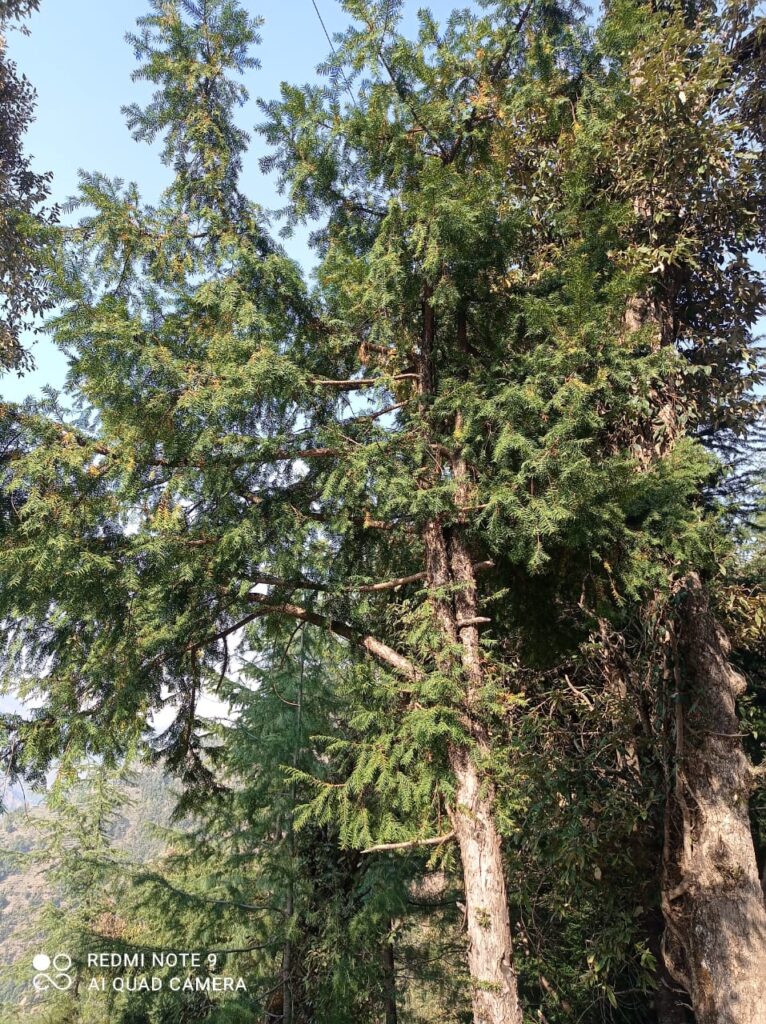
The fleshy ripened aril around the seed is edible, it is often eaten raw and can be used in dessert. This pulpy aril is very sweet, gelatinous and delicious, it can be deseeded and made into jam to preserve for off season. Seeds are however poisonous and need to be discarded before use.
Bark of rakhal is used as a substitute for tea in many parts of Western Himalayas. Tea is considered medicinal and quite often taken to cure cough, bronchitis and asthma
Rakhal is considered a sacred plant and quite often found cultivated around temples and near habitation for religious purposes. Its leaves, twigs and wood all are used in worshipping. Wood is also used to make temple and deities.
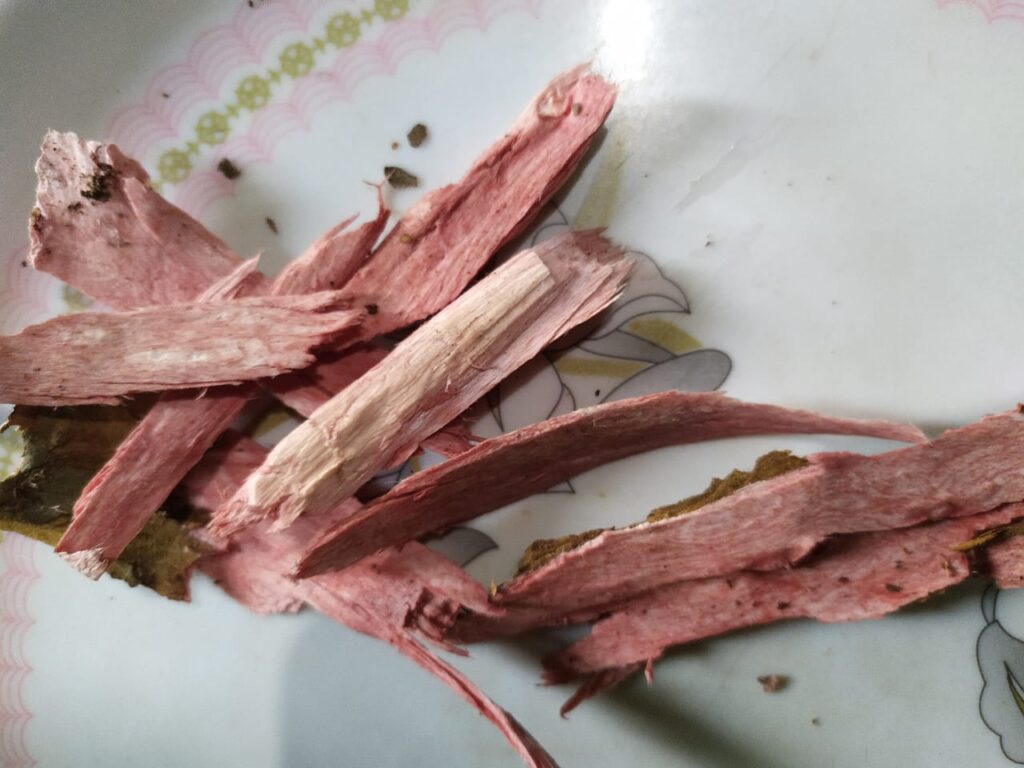
Rakhal is a multipurpose tree for the people residing in hills and collected from wild as a source of food, medicine,fuel and timber for local personal uses. Its riped seeds are center of attraction for visitors and wildlife. It is also grown as an ornamental tree in gardens and temples. However, the leaves contain an alkaloid poisonous to live-stock, but the alkaloid content varies from area to area 1. Himalaya. Rakhal is entered in list of endangered plants due to overexploitation for trade and need cultivation and awareness for sustainable use.
Rakhal Plant:
Rakhal is a small or medium sized, evergreen trees, usually upto 6m high.
Leaves are 2.5-3.8cm long, linear, flattened, distichous, acute, narrowed into a short petiole, dark green and shining above, pale yellowish- brown or rusty-red below, aromatic when dry.
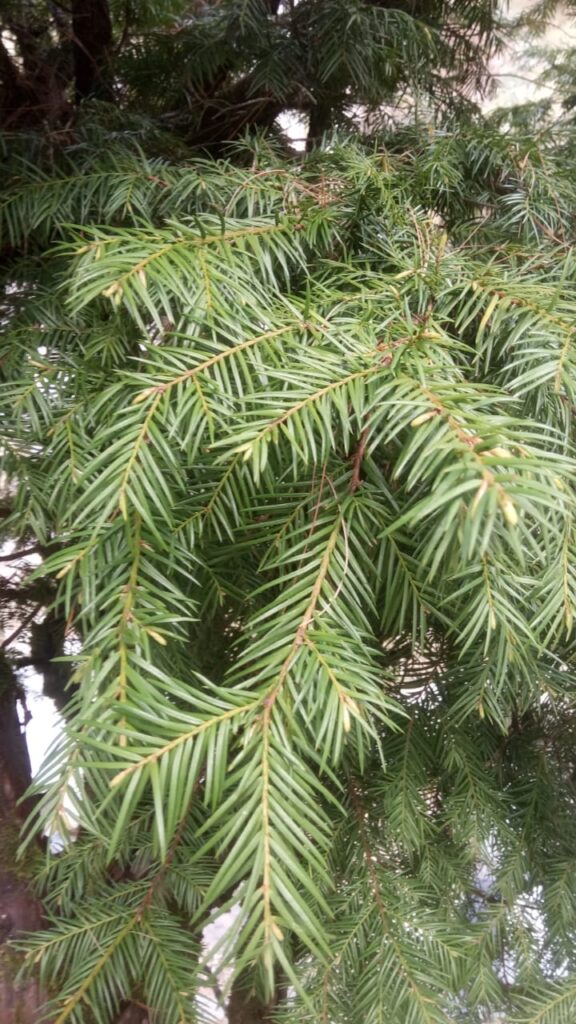
Cones usually dioecious.
Male cones sub-globose and solitary, axillary, green, with3 pairs of scales, decussate.
Ovule erect, surrounded at the base by a cup-shaped disc, which enlarges and becomes succulent and bright red at maturity.
Seed olive-green.
Edible ripened aril of rakhal is available from September to November, while bark can be collected round the year. Rakhal is listed endangered plant due to its overexploitation for trade, so need cultivation and sustainable harvesting by habitat rotation.
Edible Uses:
Pulpy aril of seed is edible and eaten raw or cooked and considered sweet, gelatinous and delicious.These are supplement in dessert and deseeded ripened aril is made into jam. Bark is used in making of medicinal tea considered good to cure cough, bronchitis and asthma.
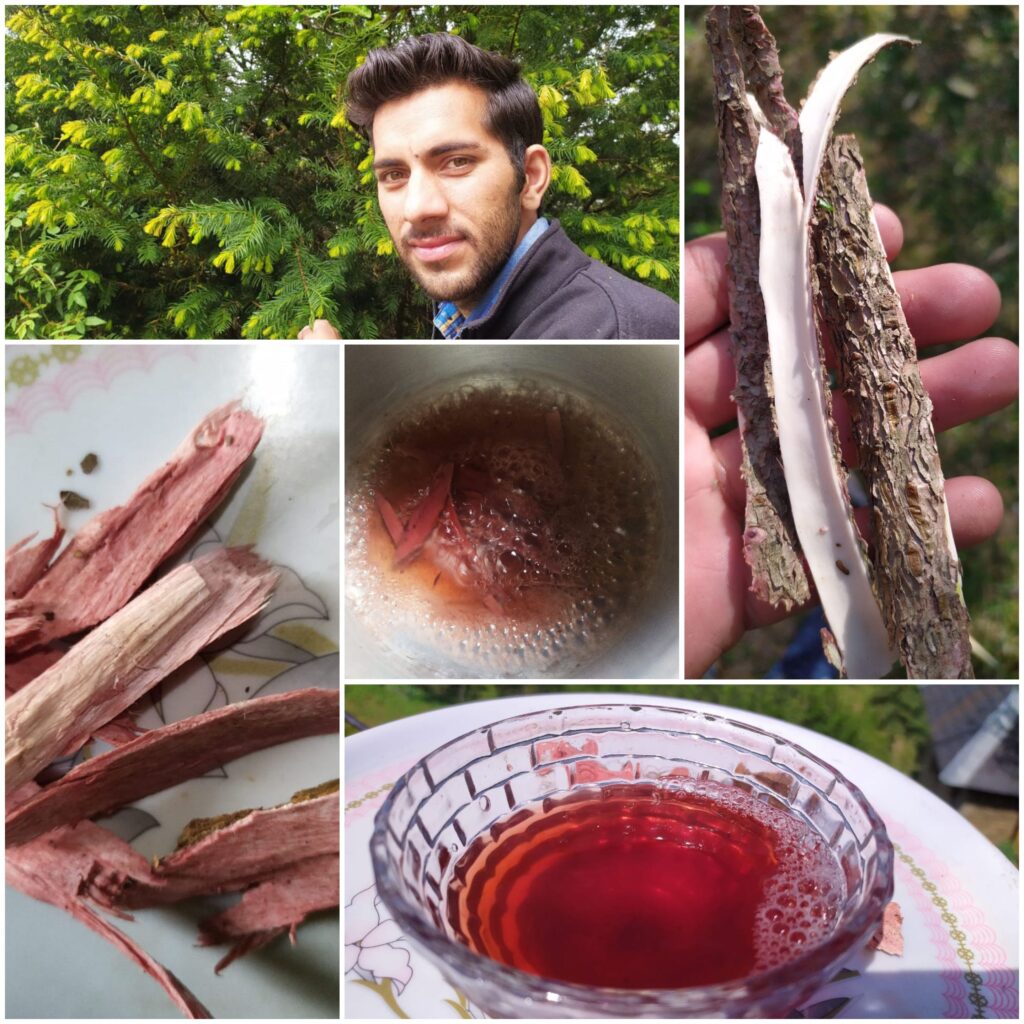
Desserts:
Ingredients:
Ripe rakhal deseeded aril and other chopped fruits acc. to taste, 250g; curd, 1/2kg; sweetener like honey/ sugar/ condensed milk, 1-3 tea spoon; cardamom powder,1/4 tea spoon; black salt according to taste.
Method:
Put ripened seed in freezer for 2 days, it will help to separate aril from seeds. Take curd in a bowl. Add to it sweetener according to choice and stir well. Add cardamom powder, black salt, deseeded aril and other chopped fruits according to preference. Mix well and serve.
Jam:
Ingredients:
Ripened deseeded aril,1 kg; sugar, 500 g; lemon juice, 4-5 tea spoon.
Method:
Put mature seed in freezer for two days, so that pulp (aril) can be easily separated from poisionous seeds. Put deseeded fruits (Aril) in pan, boil till they are soft and let them cool down. Mesh boiled fruit pulp manually or in a mixer. Place meshed pulp in a pan, add sugar to it and cook in low flame with constant stirring till sugar dissolve completely and jam become dense. Now mix it well with lemon juice and let it cool down. Jam is now ready to serve. Jam should be used fresh and can be preserved for two months.
Tea:
Ingredients:
Powdered bark, 1 tea spoon; water, 2 cup amount; sugar, 2 table spoons; lemon juice, 1/2 tea spoon and a pinch of salt.
Method:
Boil powdered bark in water. Add sugar, salt to it and simmer in low flame for 10 minutes. Strain into tea cups. Add lemon juice and serve.
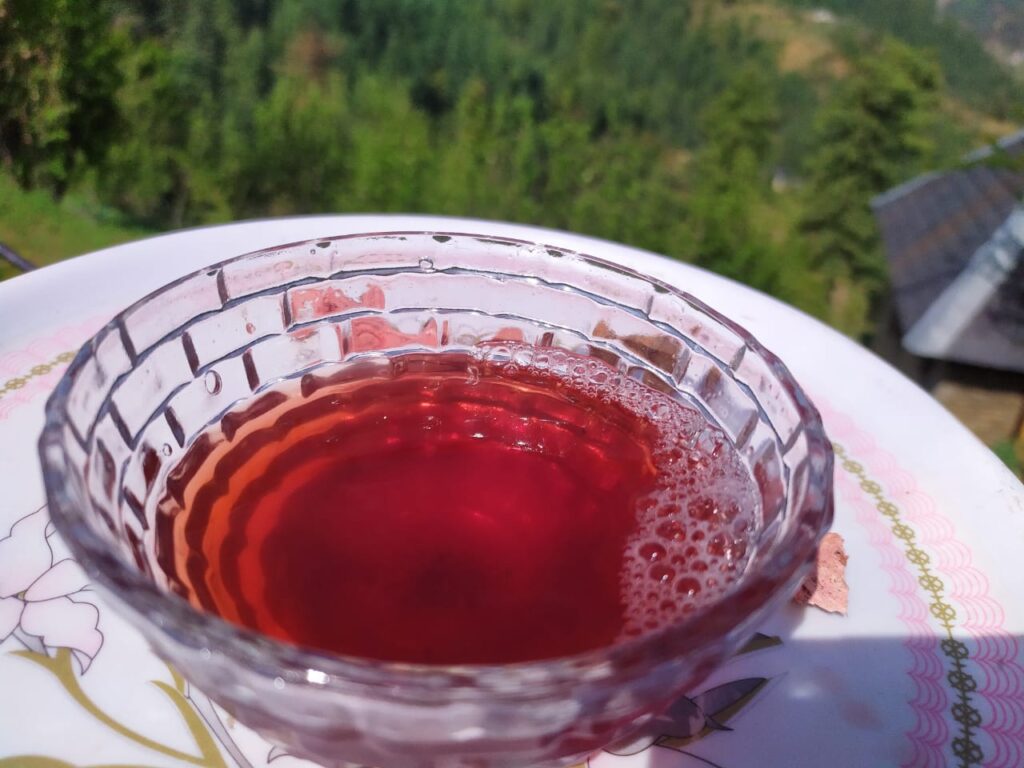
Salted Tea
In some parts of Western Himalayas salted tea is prepared from bark and is named differently in different regions. In kullu and Lahul district of Himachal Pradesh India it is called as “namkeen chai” or :looni chai” while in kinnaur district it is called as “chh-se-byai”.
Ingredients:
Powdered bark, 1 tea spoon; water, 2 cup amount; milk, 1/2 cup amount, salt according to taste; butter, 1 cube amount.
Method:
Boil bark in water and let it cooldown (luke warm or more than that),strain into a bowl or “dongmo” (a special wooden utensil made for making this type of tea). Add to it milk, salt and butter. Shake well and heat as per your choice. Now pour tea into cups and serve.

Food value:
100g of fruit contains calories from Fat 269;Total Fat, 29.9 g;Cholesterol, 288.2 mg;Sodium, 2240.9 mg;Total Carbohydrate, 75.3;Dietary Fiber ,2.7 g;Sugars, 6.8 g 2 .
Seek professional advice before treating this plant medicinally..
Medicinal Uses:
The leaves have been used internally in the treatment of asthma, bronchitis, hiccup, indigestion, rheumatism and epilepsy 3,4. Externally, the leaves have been used in a steam bath as a treatment for rheumatism4. A homeopathic remedy is made from the young shoots and the berries5. It is used in the treatment of many diseases including cystitis, eruptions, headaches, heart and kidney problems, rheumatism etc5. Leaves are also the source of Taxol, a potent anti-cancerous drug 6.
Taxol has shown exciting potential as an anti-cancer drug, particularly in the treatment of ovarian cancers7. Unfortunately, the concentrations of Taxol in this species are too low to be of much value commercially, though it is being used for research purposes7.
It is used as a remedy for pustular diseases of skin and night sweats, gout and chronic rheumatism. Complaints of supra-orbital and temporal pain of right side, with lachrymation & dilated pupil. Pain in pit of stomach and region of navel with feeling of pain and needles at the pit of stomach. Sensation of emptiness of stomach, which makes one to eat frequently. Skin with larger, flat, itching pustule8.
Chemical Constituents:
Alkaloids, Taxine, Taxinine, Ephedrine, Beta- sitosterl, Glucoside, Taxicant, Taxiphyllin, Ecdysterone, Hydrocyanic acid. Formic acid, resins8.
Religious Uses:
Rakhal is a religious plant for the local people residing in hills. Its leaves are used during worship and Wood is used to make temple and deities.So, plant is also cultivated for religious purposes around the temples.
Other Uses:
The wood is used for cabinet-marketing, furniture, poles, axles of carts, house construction, particularly shingles, as well as more specialised uses such as grave coverings and beehives1.The foliage is used as litter and fed to cattle in Pakistan 1.Wood is also uses as fule. Plant is grown as a ornamental tree near to home,garden and temples for its attractive foliage and red fruits.
Source of income:
Leaves are collected and sold as a substitute for ‘Talispatra’ of Ayurveda; used in treatment of asthma and bronchitis. Leaves are also the source of Taxol, a potent anti-cancerous drug 6.
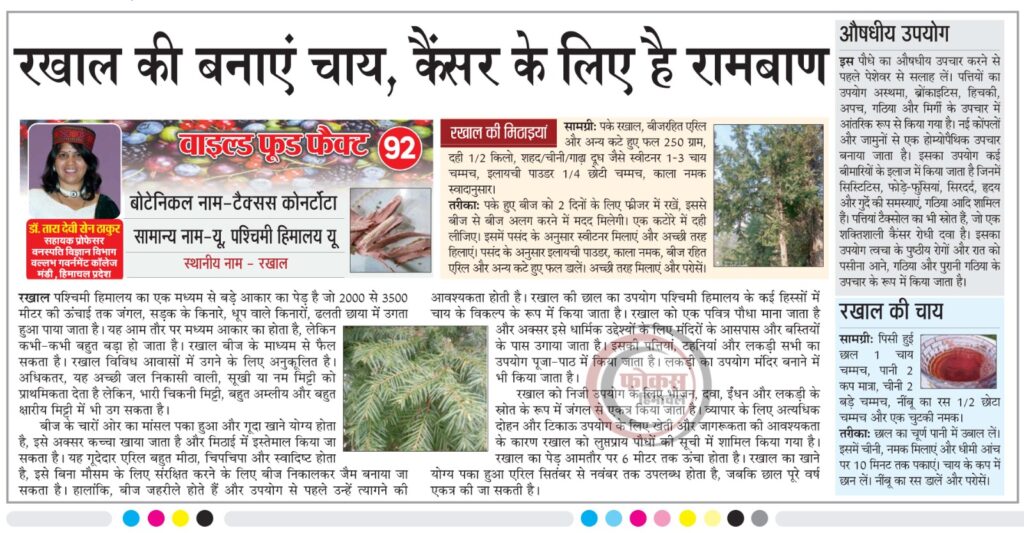
References:
- 1. Polunin, Oleg, and Adam Stainton. Flowers of the Himalaya. Oxford University Press, 1984.
- https://www.fruitsinfo.com/yew-fruit.php
- Chopra, R. N., Nayar, S. L., & Chopra, I. C. (1956). Glossary of Indian medicinal plants (Vol. 1, pp. 138-139). New Delhi: Council of Scientific & Industrial Research.
- Chevallier. A. (1996); The Encyclopedia of Medicinal Plants. Dorling Kindersley. London, ISBN, 9-780751-303148.
- 5. Grieve, M. (1984). Tansy. A Modern Herbal. Penguin Books Ltd, Middlesex, Great Britain, 789-790.
- Singh PB. (2018). Flora of Mandi district. Himachal Pradesh: North West Himalaya.
- Bown. D. (1995): Encyclopaedia of Herbs and their Uses. Dorling Kindersley, London. ISBN,0-7513-020-31.
- Purohit SS, Sharma AK, Prajapati ND, Kumar T. (2009); A handbook of medicinal plants: a complete source book. 2:352-3.

Fantastic article.Much thanks again. Cool.
I simply could not depart your site before suggesting that I actually enjoyed the usual information an individual provide to your guests? Is going to be again incessantly in order to investigate cross-check new posts.
You could certainly see your skills in the work you write. The arena hopes for even more passionate writers such as you who are not afraid to say how they believe. At all times follow your heart.
I would like to point out my passion for your kindness supporting women who should have help on your situation. Your personal commitment to passing the message up and down ended up being rather significant and have continually empowered ladies just like me to achieve their goals. Your own helpful report can mean a whole lot to me and somewhat more to my mates. With thanks; from each one of us.
Very good blog post.Much thanks again. Great.
Wow, awesome weblog format! How lengthy have you ever been blogging for? you made running a blog glance easy. The overall glance of your website is wonderful, as smartly as the content material!!
Very neat blog. Keep writing.
Major thankies for the article.Really thank you! Awesome.
Muchos Gracias for your blog post.Really thank you! Really Great.
Major thankies for the blog.Thanks Again. Cool.
Hey, thanks for the post.Really looking forward to read more. Really Cool.
Great blog.Thanks Again. Really Cool.
A big thank you for your blog article. Want more.
Hey, thanks for the article. Cool.
Im obliged for the article post.Thanks Again. Cool.
This is one awesome blog post. Will read on…
Thanks-a-mundo for the post.Really looking forward to read more. Awesome.
Major thanks for the blog article.Much thanks again. Will read on…
A round of applause for your blog. Really Cool.
A big thank you for your blog article.Thanks Again. Really Great.
A big thank you for your article.Really thank you! Want more.
Great, thanks for sharing this blog post.Much thanks again. Much obliged.
I really enjoy the blog post.Thanks Again. Really Great.
Im grateful for the post.Thanks Again. Will read on…
Appreciate you sharing, great post.
A big thank you for your article post.Much thanks again. Want more.
Thanks a lot for the blog. Really Cool.
Thanks for sharing, this is a fantastic blog.Much thanks again. Keep writing.
Hola, deseo suscribirme a este sitio web para obtener las actualizaciones más recientes, por lo tanto, ¿dónde puedo hacerlo? Por favor, ayúdenos.
I appreciate you sharing this blog article.Thanks Again. Will read on…
Aloha! Interesting post! I’m really appreciate it. It will be great if you’ll read my first article on AP!)
Enjoyed every bit of your article.Much thanks again. Keep writing.
Im grateful for the article.Thanks Again. Really Great.
It’s hard to find knowledgeable people on this topic, but you sound like you know what you’re talking about! Thanks
Thanks for the blog post.Thanks Again. Awesome.
Really enjoyed this blog post.Really looking forward to read more. Cool.
I value the article post.Really thank you! Fantastic.
I cannot thank you enough for the blog. Really Cool.
Hi. Interesting material! I’m really appreciate it. It will be great if you’ll read my first article on AP!)
Hello. Interesting material! I’m really enjoy this. It will be great if you’ll read my first article on AP!)
Thanks-a-mundo for the article post. Fantastic.
Thanks a lot for the blog article. Much obliged.
A round of applause for your blog. Great.
I loved your blog.Much thanks again. Cool.
Very neat blog article.Much thanks again. Really Great.
A big thank you for your blog article.Much thanks again. Awesome.
Looking forward to reading more. Great blog. Cool.
Major thankies for the blog article.Much thanks again. Much obliged.
I really liked your blog post.Really looking forward to read more. Much obliged.
Thank you for your article.Much thanks again. Cool.
I loved your blog article.Really thank you! Great.
Hey, thanks for the post.Really thank you! Really Great.
I am so grateful for your blog post.Much thanks again. Really Great.
Hey!. Interesting post! I’m really enjoy this. It will be great if you’ll read my first article on AP!)
Very informative blog article. Really Cool.
I am in fact happy to read this web site posts which contains plenty of helpful information, thanks for providing these kinds of data.|
Hey!. Interesting post! I’m really enjoy this. It will be great if you’ll read my first article on AP!)
Really informative blog post.
Really informative blog article.Really looking forward to read more. Fantastic.
Really informative blog.Really thank you! Really Great.
Aloha! Interesting material! I’m really enjoy this. It will be great if you’ll read my first article on AP!)
Relaxing the muscles of a part of the body or the whole body through a series of physical stimuli to muscles and joints.
Thanks-a-mundo for the article post.Really thank you! Will read on…
It is a high-end technology that needs to be able to identify and effectively stimulate the blood vessels, meridians, etc. of the human body.
Through thorough verification, we select and recommend sites that members can use with confidence.
Full body massage will be a useful technology in many ways. It is good for relieving stress of friends and family members, and it can also help relieve pain or pain of people around them.
A big thank you for your post. Great.
Wow, great blog. Will read on…
I truly appreciate this blog article. Much obliged.
Very good blog post.Really thank you! Really Great.
A round of applause for your blog article.Thanks Again.
Hello. Interesting post! I’m really appreciate it. It will be great if you’ll read my first article on AP!)
I really enjoy the post.Really thank you!
Hi. Interesting post! I’m really appreciate it. It will be great if you’ll read my first article on AP!)
I cannot thank you enough for the post.Really looking forward to read more. Really Great.
Hi. Interesting material! I’m really appreciate it. It will be great if you’ll read my first article on AP!)
This is one awesome blog post.Really thank you! Much obliged.
Hi. Interesting post! I’m really appreciate it. It will be great if you’ll read my first article on AP!)
Hi. Interesting post! I’m really enjoy this. It will be great if you’ll read my first article on AP!)
Hi. Interesting post! I’m really appreciate it. It will be great if you’ll read my first article on AP!)
Aloha! Such a nice post! I’m really enjoy this. It will be great if you’ll read my first article on AP!)
Hello. Awesome! I’m really enjoy this. It will be great if you’ll read my first article on AP!)
A big thank you for your blog post.Really looking forward to read more. Keep writing.
You should take part in a contest for one of the highest quality sites on the net.
I will highly recommend this website!
What’s up, after reading this awesome pst i am aas well delighted to share my experience here withfriends.
You’ve made some decent points there. I looked on the internet for more info about the issue and found most people will go along with your views on this web
site.
I absolutely love your blog and find many of your post’s to be exactly what I’m looking for.
can you offer guest writers to write content in your case?
I wouldn’t mind writing a post or elaborating on a number
of the subjects you write related to here. Again, awesome site!
how long does 25mg viagra last how to make natural viagra with immediate effect! canadian pharmacy ezzz viagra
Nice answers in return of this difficulty with genuine arguments and explaining everything on the topic of
that.
Magnificent site. A lot of useful info here. I am sending it to a few friends ans also sharing in delicious. And certainly, thanks for your sweat!
WONDERFUL Post.thanks for share..more wait .. …
F*ckin’ awesome things here. I am very glad to see your article. Thanks a lot and i am looking forward to contact you. Will you kindly drop me a e-mail?
My programmer is trying to persuade me to move to .net from PHP. I have always disliked the idea because of the expenses. But he’s tryiong none the less. I’ve been using WordPress on numerous websites for about a year and am concerned about switching to another platform. I have heard fantastic things about blogengine.net. Is there a way I can transfer all my wordpress posts into it? Any kind of help would be really appreciated!
I’ll immediately snatch your rss feed as I can not to find your e-mail subscription link or e-newsletter service. Do you’ve any? Please let me know in order that I may subscribe. Thanks.
My programmer is trying to persuade me to move to .net from PHP. I have always disliked the idea because of the costs. But he’s tryiong none the less. I’ve been using WordPress on a number of websites for about a year and am anxious about switching to another platform. I have heard excellent things about blogengine.net. Is there a way I can import all my wordpress content into it? Any help would be greatly appreciated!
As I site possessor I believe the content matter here is rattling wonderful , appreciate it for your efforts. You should keep it up forever! Best of luck.
Good post. I be taught something more challenging on completely different blogs everyday. It is going to always be stimulating to learn content material from different writers and observe a bit of one thing from their store. I’d choose to make use of some with the content material on my blog whether or not you don’t mind. Natually I’ll give you a link in your net blog. Thanks for sharing.
Hey fantastic website! Does running a blog similar to this take a large amount of work?
Good Work
Very neat article post.Thanks Again. Really Great.
Sensational will provide you a lot of amazing chances.
I do accept as true with all of the ideas you have introduced to your post. They’re really convincing and can definitely work. Nonetheless, the posts are very short for starters. Could you please prolong them a little from next time? Thanks for the post.
Take a look at just how this one tool can transform your life right!
Have you ever considered about adding a little bit more than just your articles? I mean, what you say is fundamental and everything. Nevertheless imagine if you added some great images or videos to give your posts more, “pop”! Your content is excellent but with pics and videos, this site could definitely be one of the best in its field. Awesome blog!
Thanks for another informative website. Where else could I get that type of information written in such a perfect way? I’ve a project that I am just now working on, and I’ve been on the look out for such information.